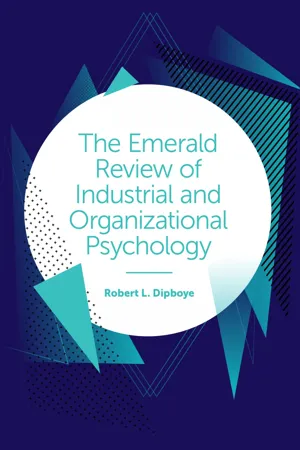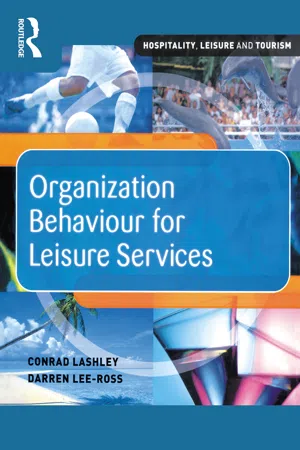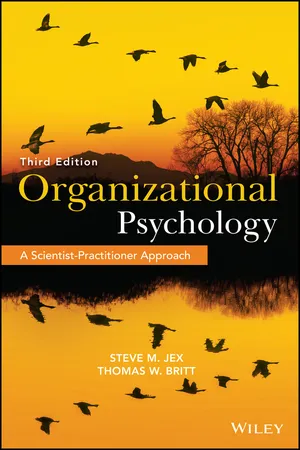Business
Job Attitude
Job attitude refers to an individual's feelings and beliefs about their job. It encompasses their overall satisfaction, commitment, and emotional attachment to their work. Positive job attitudes can lead to higher productivity, better job performance, and lower turnover rates, while negative attitudes can have the opposite effect. Understanding and managing job attitudes is crucial for creating a positive work environment and promoting employee well-being.
Written by Perlego with AI-assistance
Related key terms
Related key terms
1 of 4
Related key terms
1 of 3
10 Key excerpts on "Job Attitude"
- eBook - ePub
Work, Organizational, and Business Psychology
An Introductory Textbook
- Hannes Zacher, Nale Lehmann-Willenbrock, Hannes Zacher, Nale Lehmann-Willenbrock(Authors)
- 2022(Publication Date)
- Kohlhammer Verlag(Publisher)
Consistently, work attitudes have been defined as evaluations of certain entities related to one’s work (including job, organization, etc.) that involve feelings toward, beliefs about, and attachment to these entities (Judge & Kammeyer-Mueller, 2012). Work attitudes differ from work-related perceptions and descriptions (e.g., job characteristics) because they include an evaluation. Work attitudes, such as job satisfaction or organizational commitment, are important to study because work is a major part of most people’s lives (Chap. 1), and because work attitudes typically predict some corresponding work behavior, such as job performance or turnover. At the same time, organizational researchers have acknowledged that work behavior might also influence work attitudes (Judge & Kammeyer-Mueller, 2012). For instance, employees who perform well on the job or invest into their organization (e.g., through training) might become more satisfied with their job and more committed to their organization over time. In this chapter, we present definitions, theories, and empirical findings on important work attitudes (i.e., job satisfaction, job involvement, work centrality, organizational commitment, organizational identification, turnover intentions). We invite you to keep Lily’s situation in mind and think about how you might employ the described concepts, theories, and evidence to her situation. In addition to classic and contemporary work attitudes, we also cover research on organizational justice perceptions, trust, and the psychological contract in this chapter. Organizational justice research addresses the question of how fairly employees feel treated in and by their organization (Greenberg, 1990), and trust entails employees’ willingness to be vulnerable to the organization’s actions (Mayer et al., 1995). The employment relationship involves the mutual material and immaterial exchanges between an employee and their employing organization (see social exchange theory in Chap - Robert L. Dipboye(Author)
- 2018(Publication Date)
- Emerald Publishing Limited(Publisher)
Fig. 4.1 . A work-related attitude is reflected most obviously in the feelings expressed about the work (e.g., “…a living hell”). They are also expressed in the beliefs about the job (e.g., “The work is physical and demanding”) and the behavioral inclinations of the respondent (e.g., “I’m ready to quit”). An employee holding a positive attitude is more likely to have positive feelings, beliefs, and behavioral inclinations than is an employee with a negative attitude.Fig. 4.1. The Evaluative, Cognitive, and Behavioral Components of Work-Related Attitudes.Employees form work-related attitudes that are relatively stable and have important consequences. They influence not only the effectiveness with which employees perform their jobs, but also their health and well-being. I/O psychologists have devoted most of their efforts to studying three work-related attitudes: job satisfaction, organizational commitment, and job involvement. Of these, job satisfaction and organizational commitment have received the most attention (Judge, Weiss, Kammeyer-Mueller, & Hulin, 2017). Job involvement has received the least attention but the recent popularity of worker engagement has seen the revival of a repackaged construct having involvement as a core component. This chapter reviews the research and theory for three work-related attitudes: job satisfaction, job involvement, and organizational commitment. The review of the research is organized around four primary questions: How is the attitude measured, and what are the facets or components of the attitude? What are the correlates? What is the process by which the attitude forms? Do satisfaction, involvement, and commitment reflect the same or different constructs? The chapter concludes with a discussion of practical implications.- Valerie I. Sessa, Nathan A. Bowling, Valerie I. Sessa, Nathan A. Bowling(Authors)
- 2020(Publication Date)
- Routledge(Publisher)
Table 1.1 ). Although less widely studied than job satisfaction, the remaining Job Attitudes examined in the current book have each been referenced several thousand times. Needless to say, we have a lot of ground to cover. Our goal in this opening chapter is to clear a path for the subsequent chapters. We first define the term “Job Attitude.” We then discuss why Job Attitudes (and the other workplace psychological constructs) are important—what, in other words, are their theoretical and practical significance? Finally, we present an overview of the subsequent chapters.Table 1.1 Number of Google Scholar References in Various Job Attitude ConstructsJob Attitude Number of Google Scholar References Chapter Organizational Justice > 91,000 3 Perceived Organizational Support ~ 58,000 4 Organizational Identification > 42,000 5 Job involvement > 49,000 6 Organizational Commitment ~ 476,000 7 Job Embeddedness > 10,000 8 Job Satisfaction > 1,700,000 9 Employee Engagement ~ 110,000 10 Note : These results were based on a Google Scholar search conducted on April 30, 2020.Defining Job Attitudes and Other Workplace Psychological Constructs
In describing the nature of Job Attitudes, I-O psychologists draw heavily from the social psychological definition of the term “attitude.” Social psychologists describe attitudes as representing a person’s evaluative response toward an attitude object (Eagly & Chaiken, 1993). As Wagner notes in Chapter 2 , attitudes have valence—a positive or negative direction (e.g., good vs. bad)—and they differ in the intensity associated with that valence (e.g., extremely good vs. moderately bad; Wagner, Chapter 2- eBook - ePub
- Dolores Albarracin, Blair T. Johnson, Dolores Albarracin, Blair T. Johnson(Authors)
- 2018(Publication Date)
- Routledge(Publisher)
Figure 7.1 ), and research in this area is growing. Nonetheless, in the top journals (AMJ and JAP), job satisfaction, organizational commitment, and job involvement have declined in popularity since their heyday inTable 7.5 Summary of Main Points on Job AttitudesFour Job Attitudes. "Job Attitudes" include: – Job satisfaction – Organizational commitment – Job involvement – Work engagement Popularity. – Job Attitudes are perhaps the most influential topic in the field of OB/HR, in terms of reputation and number of papers published on the topic. – Across the entire field, the number of published papers per year onJob Attitudes is quickly increasing. – In the top journals (AMJ and JAP), the total number of papers per year onJob Attitudes has remained fairly stable, but the % of papers onjob satisfaction and organizational commitment has decreased since the 1980s, job involvement research has disappeared, and work engagement research is quickly increasing. Definitions. – Of the four Job Attitudes, only job satisfaction has been clearly defined as an attitude (overall positive or negative evaluation of one’s job). – The other three Job Attitudes (organizational commitment, job involvement, work engagement) seem to be defined as a mixture of attitudes, beliefs, and behavioral intentions. Measurement. – There is little consensus in the measurement of job satisfaction; researchers currently use more than a half dozen different measures to assess the construct. – In contrast, there is good consensus in the measurement of organizational commitment (i.e., 83% of commitment papers use the OCS or the OCQ, which are correlated rc= .88 with each other) and in the measurement of work engagement (i.e., 76% of engagement papers use the UWES).– Very few contemporary papers measure job involvement. - eBook - ePub
Britain At Work
As Depicted by the 1998 Workplace Employee Relations Survey
- Mark Cully, Andrew Oreilly, Gill Dix(Authors)
- 1999(Publication Date)
- Routledge(Publisher)
8Employee attitudes to work
In this chapter we move into the realm of organisational psychology, trying to relate the substantive content of people’s jobs to what they think of their work and their workplace. People’s subjective assessments of their well-being at work may be affected by a variety of factors. Gallie et al. (1998) identify four: the nature of the work task; social integration in the workplace; participation in decision-making; and job security. Guest and Conway (1998) have an alternative list of ‘antecedents’ of motivation. In their model, how the workplace is managed and the organisational climate, together with individuals’ experience of employment, help to determine the three elements of the ‘psychological contract’: fairness, trust, and delivery on promises made. These, in turn, shape peoples attitudes to their work.Common to both explanations is a recognition that people have different ‘work orientations’, the underlying values they bring to their work. It may be that these values differ systematically across particular types of workers so that, when we observe differences in attitudes, they are set against a varied tapestry of values. If, for example, part-timers have higher levels of job satisfaction than full-timers, is this because their jobs are ‘better’ in some objective sense, or part-timers are more easily satisfied? Differences in work orientations have also been explored across occupations, for example between professional and manual workers. We alluded to some of these differences in the last chapter when exploring reasons for working overtime.It is most important to note that we did not attempt to define or measure employees’ work orientations. This is an area where sociologists of work have been unable to agree on reliable measures, and one which is certainly not within the scope of a relatively short questionnaire. Can patterns in the attitudes of employees, identified in our results, be attributed to aspects of their employment relationship rather than differences in personal, underlying values? Our approach is to establish whether general patterns found in the data are consistent within sub-groups whose work orientation, we might anticipate, may be similar. If such patterns are found to persist, then they are likely to be independent of work orientation. The main employee characteristics we focus on are gender, occupation and the four-way division of working hours used in the last chapter. - eBook - ePub
Personality and Intelligence at Work
Exploring and Explaining Individual Differences at Work
- Adrian Furnham(Author)
- 2008(Publication Date)
- Routledge(Publisher)
This chapter will also look at research in a number of these areas. The focus will be on how, when and why these attitudes, beliefs and value systems predict behaviour at work. This chapter will also explore the concept of style. There is a vast literature on style – cognitive style, learning style, attribution style, and coping style. For some, the concept of style is a nice bridge between traits and abilities while for others it is a poor muddled compromise. Some attitudinal variables are extremely well researched and ignored. Thus, there is a great interest in job satisfaction, which has been variously conceived as work commitment, or engagement or centrality (Hirschfeld & Field, 2000). Most studies on these topics have tried to identify the causes, correlates and consequences of these beliefs.Before proceeding, however, it is important to answer two fundamental questions:1. What is the essential difference between the concepts of attitudes, beliefs and values?
Beliefs are thoughts about concepts, events, objects or people; or about the relationship between these things. Beliefs do not have an evaluative (good/bad, like/dislike) component. One can have beliefs about the functions of marketing or the movement of the stock market. Traditionally, social psychologists are interested in attitudes to things like work, one’s boss, or the organisation. They are usually defined as relatively stable, affective or evaluative dispositions towards a particular person, situation or thing. They have three components: cognitive, evaluative and behavioural. They form into bundles, constellations or theories. Thus, job satisfaction is essentially an attitude to the job. People also have very specific attitudes like those toward work schedules, or the labour unions or physical working conditions.People have attitudes to, at and about work. There have been literally dozens of studies about attitudes to appraisal, flexitime, pay, promotion, retirement, tenure and work–life balance. Some are theory driven, others are not. How they measure attitudes differs, and comparatively few examine how personality traits and cognitive abilities are related to these attitudes. Even fewer examine the relationship between attitudes to, and specific behaviour concerning, a particular issue at work.Attitudes are functional and they guide behaviour. Because work is such an important part of people’s lives, they quite naturally have strong, complex and diverse attitudes to it. However, attitudes to (and indeed behaviour at) work may be shaped by strongly held social values. Everyone has certain implicit and explicit values that reflect their unique upbringing, their education and the wider culture within which they live. Some of their values are overtly materialistic, others completely spiritual. These values about freedom, equality and altruism are very relevant in the workplace. For instance, they are partly responsible for where - eBook - ePub
- Darren Lee-Ross, Conrad Lashley(Authors)
- 2012(Publication Date)
- Routledge(Publisher)
Worker attitudes commonly are obtained using questionnaires. These forms can be custom made by managers but there are also several standard instruments available for this purpose. For example, Hackman and Olham’s (1974; 1980) Job Diagnostic Survey (JDS) has proved popular and targets job tasks, linking them with the outcome attitude of job satisfaction.Question statements they use are based on the above three-component view of attitudes and require respondents to indicate their opinions using a Likert-type scale (scale of 1 to 7 with 1 being ‘low’ or ‘poor’ and 7 being the opposite). Average employee scores are then calculated to give a summary diagnosis for all elements of work, including job satisfaction.In addition to job satisfaction, alternative collective terms are also used by other instruments including:- ‘job involvement’
- ‘organizational commitment’.
The former represents the degree to which a person identifies with their job, participates willingly in it and considers performance crucial to self-worth. The latter is the degree to which a person identifies with an organization and wishes to remain with that organization.However, with the gradual but definite erosion of ‘jobs for life’, the continued use of organizational commitment as a valid outcome attitude is questionable. This is particularly relevant for the services sector because employment patterns have always been ‘non-traditional’ or part-time, split-shift and temporary. Perhaps job involvement is more important in this sense because jobs are not organization specific. Evidence suggests this to be the case among hospitality workers where occupational communities are rife (see Chapter 8 and Lee-Ross, 1996).Notwithstanding the collectives of involvement and commitment, job satisfaction remains a popular ‘catch-all’ and in many respects is a composite attitude. Most people have an intuitive understanding of job satisfaction and the behavioural outcomes ascribed to it. Simply, someone who has a high level of job satisfaction ‘usually’ has positive attitudes toward their job. - eBook - ePub
- Craig C. Pinder(Author)
- 2014(Publication Date)
- Psychology Press(Publisher)
Aside from the historical significance of the phenomena, the more important issue, for this author, is the tremendous significance they have as experienced by working people. Those who have experienced the joys of working know what this means, as do those who have suffered the frustrations of job and career dissatisfaction: They really hurt, and they deliver significant impacts on our daily lives, both while we are actually at work as well as when we are not.A glance ahead
Whereas Part Two of this book approached the motivation to participate and the motivation to perform from a needs perspective, Part Three looks at these two elements of work motivation from the perspective of people’s attitudes and beliefs. In short, the purpose here is to understand how certain job-related attitudes may or may not be related to the desire of people to participate in organizations and to perform well for those organizations. Now that we have examined job satisfaction in detail, we turn our attention to work commitment, a set of attitudes, beliefs, and intentions that people form in reference to their employers, as opposed to their jobs per se.Work Commitment
Whereas job satisfaction generally has to do with the degree to which one’s needs or values are satisfied by one’s job, work commitment is a multidimensional construct that is somewhat broader in scope. Specifically, work commitment is currently seen as comprising several dimensions, such as adherence to a work ethic (see Chapter 1 of this book), commitment to a career or a profession, job involvement (the degree of daily absorption in everyday work experiences), and organizational commitment (the degree of loyalty a person holds for a particular employer) (see Blau & Paul, 1993; Morrow, 1993). Space limitations here require that we focus primarily on the third and fourth varieties of work commitment identified by Morrow (1993) : Organizational commitment and job involvement. The interested reader is referred to Morrow (1993, Chapter 1 ) and to Chapter 1 of this volume for a discussion of the issue of the Protestant work ethic, and to Morrow (1993, Chapters 2 and 3 - eBook - ePub
Organizational Psychology
A Scientist-Practitioner Approach
- Steve M. Jex, Thomas W. Britt(Authors)
- 2014(Publication Date)
- Wiley(Publisher)
Traditionally, the characteristics of jobs, and other aspects of the work environment, have explained differences in job satisfaction. In general, job satisfaction tends to be highest when the characteristics of a job match the employees' expectations in areas that are deemed important. In recent years, it has been proposed that job satisfaction is due to cues from the social environment, as well as stable dispositions. In reality, job satisfaction is likely the result of a complex interaction among job characteristics, social cues, and dispositions, in addition to the culture in which employees are raised.Research has shown that job satisfaction is consistently related to other measures of positive and negative affect. Evidence suggests, however, that job satisfaction is only a very weak predictor of absenteeism. Job satisfaction has been found to be related to turnover, albeit indirectly and only when employees perceive the existence of alternative employment opportunities. In general, research suggests that the relationship between job satisfaction and job performance is not strong. Under certain conditions, such as when rewards are directly tied to performance, there is evidence that the two may be more strongly related. Evidence also suggests that job satisfaction is a much better predictor of organizational citizenship behavior than it is of in-role performance. It has also been shown that the satisfaction–performance relationship may be stronger at the aggregate rather than the individual level.Organizational commitment reflects employees' feelings of loyalty toward the organization and their willingness to maintain membership. Employees may be committed because they have positive feelings toward the organization (affective), because they realize that the costs of leaving outweigh the benefits (continuance), or because they feel morally obligated to stay (normative). Affective and normative commitment can be explained largely on the basis of Equity Theory. Feelings of commitment represent employees' desires to reciprocate what they consider fair and equitable treatment at the hands of the organization. Continuance commitment, on the other hand, is due largely to employees' perceptions of sunk costs - eBook - ePub
The Psychology of Work
Theoretically Based Empirical Research
- Jeanne M. Brett, Fritz Drasgow(Authors)
- 2002(Publication Date)
- Psychology Press(Publisher)
Weiss (in press ) reviewed the evidence for the importance of these distinctions. We will not go into the details of the evidence here, but some of its elements include data showing factor structures separating the three constructs and data showing that affective experiences with attitudinal objects have causal influences on overall evaluations separate from the effects of beliefs. Generally, none of the evidence is consistent with affect and beliefs being components of attitudinal evaluations and all is consistent with affective experiences and beliefs being separate, if related, causes of the evaluations. Our point is that attitude and evaluation are equivalent constructs that are distinct from affect, and affect, along with beliefs and behaviors, help determine the evaluation. But, at the same time, the three coexist and overlap in a domain of associations linked to the object.Some other important aspects of evaluation can be mentioned. They are often formed automatically (Pratto, 1994 ). They vary in strength, or more properly, the association between the evaluation and the mental representation of the object can vary in strength (Fazio, 1989 ). They can sometimes be made without conscious awareness (Zajonc, 1980 ). We are able to develop quite reasonable post hoc explanations for evaluations made for reasons we are unaware of (Tesser & Martin, 1996 ). They help organize our thoughts about the object and serve as heuristic devices for making judgments about other aspects of the object (Pratkanis & Turner, 1994 ).Why Job Satisfaction Is Evaluation?
Some researchers define job satisfaction as an emotional or affective reaction to one’s job (Cranny, Smith, & Stone, 1992 ; Locke, 1976 ). Others define it as the attitude one holds toward one’s job (Brief, 1998 ; Miner, 1992 ). Still others hold both points of view, accepting the classic idea that attitudes are partly affective responses (Smith et al., 1969 ).Our preference, which we think is well supported by the literature, is to accept job satisfaction as the attitude one holds toward one’s job. However, we want to make clear that consistent with the basic literature on attitudes, to say that job satisfaction is an attitude is to say that it is the evaluation we make with our job as the object of evaluation. Accepting job satisfaction as an attitude is to also say, simultaneously, that it is not an affective reaction even though it is likely to be related to affect. This latter position runs counter to much that has been and is written on job satisfaction.
Index pages curate the most relevant extracts from our library of academic textbooks. They’ve been created using an in-house natural language model (NLM), each adding context and meaning to key research topics.
Explore more topic indexes
Explore more topic indexes
1 of 6
Explore more topic indexes
1 of 4









